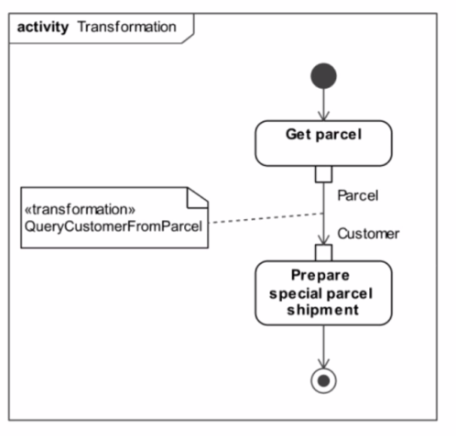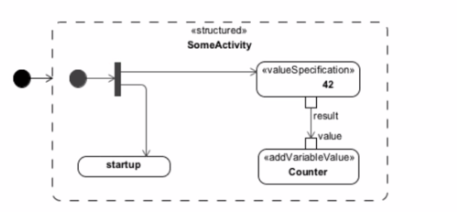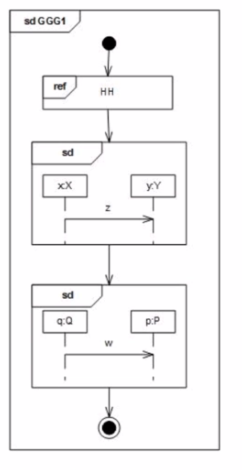Master OMG-OCUP2-ADV300 Exam with Reliable Practice Questions
Choose the correct answer:
Consider the following diagram fragment:

What is "QueryCustomerFromParcel"?
Correct : D
'QueryCustomerFromParcel' is annotated with the transformation stereotype, which indicates that it is a behavior element that specifies how to convert input objects into output objects. Therefore, the answer is D, a Behavior element, for example, an Activity, State Machine, or OpaqueBehavior. In UML, the transformation stereotype is applied to specify that an action or activity is responsible for transforming an input (in this case, 'Parcel') into an output ('Customer'), typically by employing a specific behavior element.
UML 2.5 Specification: Section on Object Flows describes how transformations can be used within activity diagrams to turn inputs into outputs using behavior elements.
Start a Discussions
Choose the correct answer:
Consider the following diagram fragment:

What is the value of "Counter" before the SomeActivity Action is executed?
Correct : C
Before the SomeActivity action is executed, the value of 'Counter' is not specified in the given diagram fragment; therefore, we cannot assume that it has a value. This leads to the answer C, 'It is empty.' In UML, unless an initial value is explicitly specified for a variable, it cannot be assumed to have a default value.
UML 2.5 Specification: The UML specification's section on variables and actions would explain that unless initialized, variables do not have a default value.
Start a Discussions
Choose the correct answer:
What happens with a transmitted object of a send Action during transmission?
Correct : B
The answer is B, 'The transmitted object may be copied and the object identity may be changed.' When an object is sent from one action to another, it is not always guaranteed that the identity of the object will be preserved. It depends on the semantics of the transmission, which may allow for object copying, and hence the object identity may change during the process.
UML 2.5 Specification: The section on send actions within activity diagrams describes the behavior of object flows, including transmission semantics regarding object identity and copying.
Start a Discussions
Choose the correct answer:
What must a modeler do to use an Action that coordinates other Actions?
Correct : B
To orchestrate multiple actions within UML, a modeler should use StructuredActivityNodes:
A . Extending Behavior and adding desired Actions is not specifically about coordinating multiple actions; it's about defining new behaviors.
B . Correct. StructuredActivityNodes are a part of UML that provides a mechanism to group a set of actions together and manage the data flows between them, thus coordinating the actions.
C . Using the standard Action and adding desired tag values does not inherently coordinate actions.
D . Extending Action and specifying constraints to be relaxed or removed does not directly relate to coordinating other actions.
UML Specification: Activities section, which describes the use of StructuredActivityNodes.
The use of StructuredActivityNodes for coordinating actions is elaborated in the UML 2.5 Documentation under Activity Diagrams.
Start a Discussions
Choose the correct answer:
Consider the following diagram:

When this behavior is executed, which event will occur last?
Correct : C
The sequence diagram depicts interactions over time between different entities. To determine the order of events, one must follow the flow of messages from top to bottom, as this represents the chronological order in which these interactions occur.
In the given diagram, 'HH' is a lifeline that is eventually destroyed, indicated by the finalization (cross) symbol at the bottom of its lifeline. The reception of 'z' is an event that happens between the lifelines labeled 'xX' and 'yY', and the reception of 'w' is an event that happens between 'q:Q' and 'p:P'. Since sequence diagrams are read from top to bottom, the message 'w' is the last one before the destruction of 'q:Q', which is indicated by the destruction occurrence specification (cross) at the bottom of 'q:Q'. Therefore, the last event that occurs according to the diagram is the reception of 'w'.
Reference to UML 2 specifications include:
UML 2.5 Specification (formal/2017-12-05), by Object Management Group, which describes the semantics of sequence diagrams, interactions, and the interpretation of message flows and lifeline termination.
Sequence Diagrams in UML, which explain the order of interaction and message passing between lifelines.
Start a Discussions